You will learn how to start a blog today in 6 easy steps that will take about 10 to 15 minutes.
Now everyone knows making money from blogging is one of the best ways to earn passive income. But the main issue is money or investment in creating a blog. So today, I will share how to create a blog for free and make money?
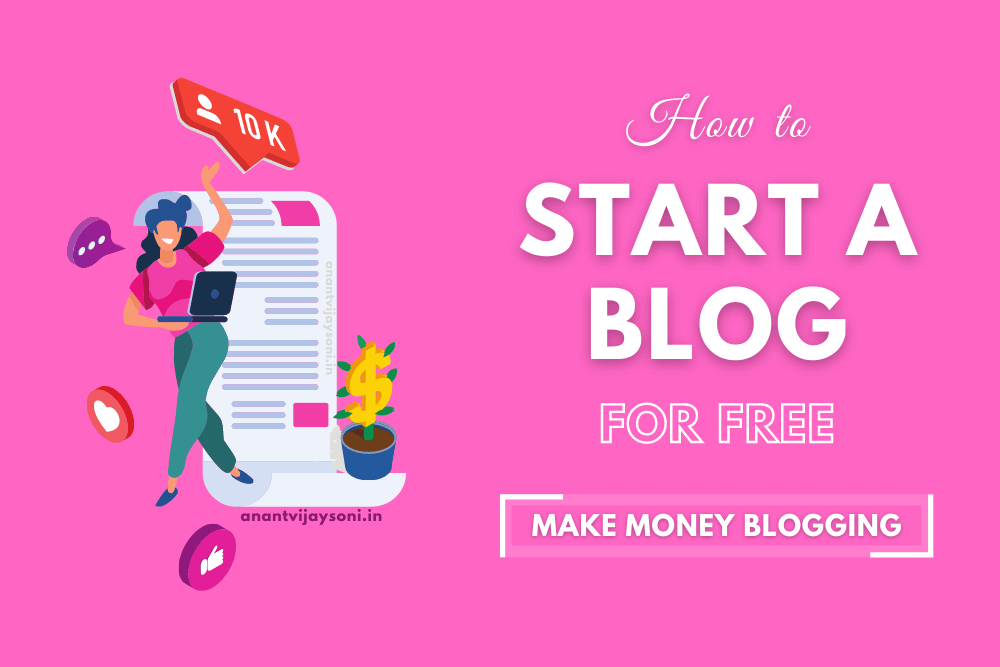
How to Start a Blog (and Make Money) in 6 Easy Steps:
The Ultimate Guide to Start a Blog and Make Money on the Side.
The Ultimate Guide to Start a Blog and Make Money on the Side.
Disclosure: Please note that some of the links below are affiliate links, which means I will receive a commission at no additional cost to you. They compensate me when you buy hosting through my Hostinger affiliate link, which helps keep this guide free for you. Be assured that I will only recommend products and services that I have personally used and can stand behind!
What is a blog?
A blog is basically a website that is regularly updated with new content, usually written in an Informal or casual, or conversational style, usually a goal to attract readers and make money on the internet. Currently, you're reading my blog, and this easy-to-follow guide will teach you how to create your own blog.
Should I start a blog?
Yes! As one of the simplest and most accessible ways to start your own business and earn an income online, creating a blog is a great place to start! (from anywhere in the world). As a blogger, you don't have to be a professional writer or web developer, and you don't need any credentials or experience in your field. There is no age, location, or experience requirement to start blogging and build a profitable online business.
Who can start a blog?
Everyone!!! Suppose you want to share your thoughts, experience, and skills with others. In that case, blogging is a great medium to reach the targeted audience. Everyone can start a blog without any technical knowledge, and even you are a beginner.
Can I start a blog without any technical experience?
No matter how little technical knowledge you have, starting a blog in 2021 is easy as making maggie, and when you started your blog and involved yourself in blogging, you will learn more and more. There was a lot of thought put into creating this guide, and I'll walk you through every step so that you can learn how to create a blog (very quickly) today.
Is it still possible to make money from a blog today?”
As per my experience, millions of people worldwide are turning to making money from home rather than working a traditional 9-to-5 job. Blogging is one of the most profitable online businesses, and you can start for free. In addition, you don't need to blog full-time. Some bloggers make six figures a year from their blogs.
In addition to my day job, I started a blog, which helped me build a six-figure freelancing career. I eventually made more money from my blog by taking advertisements and sponsorships, offering online courses, and more (which we'll discuss later).
How much does it cost to start a blog in 2024?
It's almost free to start a blog, but your cost depends on how fast you want to grow, but I suggest a small investment in the custom domain. That's the primary requirement and essential for branding. We are going to host our blog on free blogging platforms, so there is no hosting needed.
If you have a little bit of budget, You can start a blog with self-hosted wordpress; here is the complete tutorial on How to Start a WordPress Blog?
Follow these 6 steps to learn how to start a blog and make money today:
If you are ready to make a move and learn how to start a blog that will help you make a real source of online income, let’s dive in.
Now everyone know making money from blogging is one of the best ways to earn passive income. but the main issue is money or investment in creating a blog. So today I am going to share, How to create a blog for free and make money?
You will learn how to start a blog today in 6 easy steps that will take about 10 to 15 minutes.
It's time to decide on a blog name and niche because readers will first see your blog's name (like myblog.com).
You can pick a name by general topics(niche) you'll be writing about — or you could choose your own name (In my case, I am using my own name — anantvijaysoni.in), or a clever word combination, or something else entirely.
A blog niche is a general topic area or a specific topic on which you will be focusing your content. Topics such as food, travel, fashion, technology, lifestyle are good examples. Your future blog readers will appreciate it if you include a word or two in the name of your blog (like fashionbyava.com or jyotirecipiez.com) that indicates what your content is about fashion or food.
Can I decide blog name (or topic) later?
The blog name is the most important part of a blog. And if you are going with “your name” as your “blog name”, just like me. Then no issue. Now You need to decide on a niche, and you can decide it later.
Also, you can use domain name generator like Instant domain search, it will helps you decide your name
But if you want to add a niche within your blog name, you need to decide on a niche; then you can go to the next step. Because after deciding on the blog name, you can buy a domain name for your blog.
Here is some most popular niches that will make money:
- Health and Fitness
- Personal Finance
- Fashion
- Lifestyle
- Business and Marketing
- Technology and Gaming
- Travel
- Crafts Blog
- DIY blog
- Parenting Blog
- Eductional Blog
- Food Blog
What happens if the name I want to use isn't available?
As I suggested to you, you can use domain name generators like Instant Domain Search. Here you need to add your keyword, and they will show you all available domains and blog names. You can decide anyone as per your choice. Here is an example:
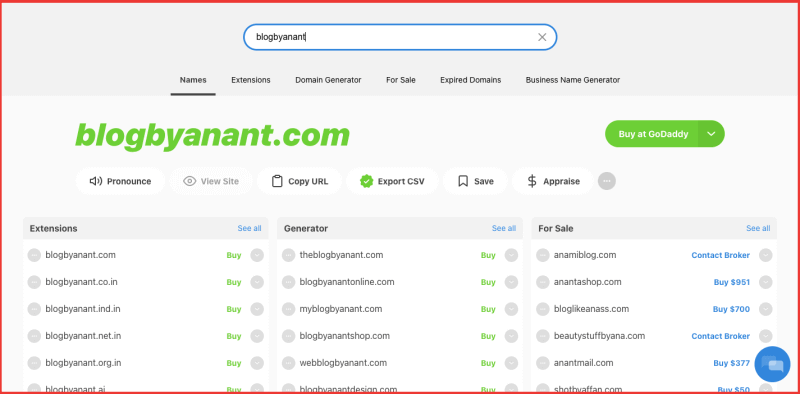
Can I change the name of my blog later?
Yes, you can change your blog name whenever you want, but you'll need to pay around $10 (Rs. 750/-) to purchase a new domain name. This step is crucial, but you can always change the name in the future, so don't let it hold you back.
The second step in starting a blog is getting your blog online. That's what free blog hosting platforms will do for you. In this step, you'll be selecting the free blogging platform where you don't need web hosting. It's 100% Free and helps you to make your blog online.
What is free blog hosting platform?
Blog Hosting Platform is a service that allows other people to access your website on the Internet. Just like you are accessing my blog (www.anantvijaysoni.in) from your home or anywhere. And there are lots of free blog hosting platforms are providing an opportunity to host your blog for free.
The two most popular Free Blogging Platforms are:
- Blogger (Blogspot)
- WordPress.com
Is it safe to use free blogging platforms?
Yes, It's 100% safe!!!
Because we are working on the world's most trusted platforms, and millions of users are already using the same platforms without any issue. Even I have started my first blog on Blogger (Blogspot), and now you can see it's a growing blog.
And my best recommended free blogging platform is “Blogger (Blogger.com)” even I have also created a complete course — Start Your Blog on Blogger.
Why we select Blogger — Free Blogging Platforms?
There are lots of benefits of Free Blogging Platforms:
- It's Free!!! — You can start without any investment.
- Unlimited — when you go for any hosting, they will provide you limited bandwidth or a limited number of visitors, or you need to upgrade your hosting for more visitors. And If you host your blog on free blogging platforms like Blogger or wordpress, No worry about monthly visits or bandwidth; it's Unlimited for you!!!
- Free Sub-Domain: Most of the popular blogging platforms provide a free subdomain( like anantvijaysoni.blogspot.com). And it's 100% Free.
- Connect Custom Domain for Free: In Blogger, you can connect custom domains for free. You don't need to pay a penny because other free blogging platforms charge a small amount for connecting a custom domain.
To start a blog in Blogger, You need only a Gmail account. Let's get started!!!
Follow the below steps to start a blog in Blogger —
- Sign in to Blogger with your Gmail id.
- Choose a name for your blog (Like “Fashion by Jyoti”) and click Next.
- Choose a blog address or URL (Like fashionbyjyoti.blogspot.com) and click Next.
- Choose your display name (Your name is displayed to readers of your blog).
- Click Finish.
- Congratulations! Your blog is ready and published. And you can check your blog's first look by clicking on the bottom left

Okay, so the next step is to connect your custom domain to your blogger blog. If you already purchased your custom domain from Hostinger, Namecheap and Godaddy then you need to use below process— Or you can purchase a custom domain from your Blogger Dashboard. Let's see in detail.
Follow the below steps to Connect a Custom Domain in your Blogger Blog —
Connect to your non-Google domain (Like Hostinger, GoDaddy) from Blogger
Step 1: Set up your domain in Blogger
-
- Sign in to Blogger.
- In the top left, select a blog.
- From the menu on the left, click Settings.
- Under “Publishing,” click Custom domain.
- Type the URL of the domain you've purchased and click Save.
- You'll get an error with two CNAMEs:
-
- Blog CNAME: For name, enter the name as the subdomain, like “blog.” or “www.” For destination, enter “ghs.google.com.”
- Security CNAME: “Name: XXX, Destination: XXX.” This security CNAME is different for each person and is specific to your blog and your Google Account.
Step 2: Set up your non-Google domain provider settings
- Go to your domain provider's website and find the Domain Name System (DNS) in the control panel.
- Under “Name, Label, or Host,” enter the subdomain from step 7 above.
- Under “Destination, Target or Points to,” enter “ghs.google.com.”
- Enter details for the second CNAME, which are specific to your blog and Google Account.
- To activate your DNS settings, wait at least one hour.
- Now, your blog is ready to access from your custom domain.
Connect to your Google Domain from Blogger
Step 1: Buy a domain from Google Domains
- Sign in to Blogger.
- In the top left, select a blog.
- From the menu on the left, click Settings.
- Under “Publishing,” click Custom domain
Buy a domain.
- At the top, search for a domain.
- Next to the domain you want, click Buy.
- Follow the on-screen instructions.
Step 2: Set up your domain with your blog
- Sign in to Blogger.
- In the top left, select a blog.
- From the menu on the left, click Settings.
- Under “Publishing,” click Custom domain.
- Enter the preferred URL for your blog.
- Click Save.
So, I hope you finished your custom domain connecting process; lets move towards designing your blogger.
Let's start the third step of creating a blog; It's designing your blog with free blogger templates/themes. It's time to have a little more fun.
If you've never worked on a blog before, you might feel a little techy with this process when it comes to designing your Blogger blog, but I promise this won't get too technical.
In addition, If you feel it's a little bit technical or cannot do it, You can check the My Blogger Course with a step-by-step video tutorial. It is a completely beginner-friendly course for newbies.
If you want to start a blog for free and make money from it, Blogger is your smartest option
Let's Learn some basic terms to know why Blogger is the best platform (also known as a Content Management System or CMS) for your blog.
What is a Content Management System (CMS)?
A Content Management System (or CMS) is where you’ll write, design, and publish your blog posts. A good and free CMS (like Blogger) is easy to use, lets you organize your content, upload images, and videos, and have control over how your entire blog looks using themes or custom design elements. The Best and Free CMS for beginners are Blogger.
What is Blogger?
Blogger — Free blog-publishing service hosted by Google. Its an most popular online content management system (CMS) which enables user to host your blog for free. Here you can create a beautiful blog with high customization options.
Should I start a blog on Blogger (or any other free platforms)?
Of course, other CMS options are to consider (such as Medium, Wix, Tumblr, Squarespace, or Typepad), but setting up a Blogger blog is the most sustainable, long-term CMS option I've seen to date. When starting a blog with the ultimate goal of making money somehow, shape, or form, this is your only 100% free option.
What if I want to create a blog with Wix or WordPress instead?
As you know, we are creating a blog for free. And if you look at the pricing page of WordPress.com or Wix.com, You will find you can create a free blog, but you need to pay some extra amount to connect your custom domain. Also, if you are thinking about making money from blogging, Blogger provides more and more options for new bloggers.
Here is top of benefits of Blogger:
- It's Free!!! — You can start without any investment.
- Unlimited — You can use limited bandwidth or a limited number of visitors; it's Unlimited for you!!!
- Free Sub-Domain: Blogger provide a free subdomain( like anantvijaysoni.blogspot.com). And it's 100% Free.
- Connect Custom Domain for Free: In Blogger, you can connect custom domains for free. But other free blogging platforms (like WordPress.com or Wix) charge a small amount for connecting a custom domain.
Lets start designing our blog by free blogger themes. So, your next question is how to get a free blogger themeand how to install and how to customize it. Let's see it in detail.
Where I get Free Blogger Templates?
Blogger is already provide some best and responsive templates. And If you need more professional and good looking blogger/blogspot templates. Here is best websites:
Download Free Blogger Templates:
- gooyaabitemplates.com (Recommended)
- btemplates.com
- soratemplates.com
- copybloggerthemes.com
How I know this template is perfect for my blog?
Over thousands of top blogger templates are available on the internet. But you need to check your requirement and well speed and layout of your template.
When you see any blogger template, You need to check the below criteria:
- Check the speed of the template or select AMP-friendly template.
- A template is responsive for all devices.
- Header, footer, and navigation style
- Documentation (Most blogger templates provide complete documentation and tutorials)
- Ads friendly (If you want to add Adsense Ads or any other ads)
How to download & install Blogger Template?
Step 1: Download A Blogger Template:
- Go to gooyaabitemplates.com
- Select the best template as per your requirement and check the demo and layout.
- If you are happy with the layout and checked all required functionality, click the Download button below every template.

- Your selected Blogger template will save (zip file) in your local computer drive (Download folder).

- Go to the download folder and extract the zip file.

- Here, you will find all the required files:
— .XML file is your main template file
— Documentation & demo content
Step 2: Install Blogger Template in Your Blog:
- Sign in to Blogger Dashboard
- Select your blog at the top left, click the Down arrow
. Click a blog to update. (If you have created multiple blogs)
- In the left menu, click Theme.
- Click on right down arrow (beside customise) for more options

- Click on Edit HTML option

- You will be redirected to HTML Code, Click anywhere in the code, select All code (Ctrl+A), and delete all code.
- Go to the downloaded and extracted file, and open . XML FILE in any HTML editor (like a notebook)
- Select All code (Ctrl+A) and Copy (Ctrl+C)
- Again, go to HTML Editor in Blogger and Paste (Ctrl+P) complete code, and click Save.
- Now, You have successfully installed the Blogger template in Blogger. And you can check the complete layout of your blog.
- Follow the documentation's instructions (provided with template) to change the layout, add, remove or modify widgets.
Not because it looks nice or because they post frequently, but rather for the content. (Although both of these are helpful.)
You read a blog because you are interested in what it has to say about a particular topic. What will bring you readers and eventually help you make money blogging is creating quality content that is engaging and informative?
A few questions must be answered before you start on the journey of developing a blog business plan and creating a content roadmap, and writing your first blog post… Why?
- Why do you care about the topic you are writing about?
- Why should anyone care about what you are saying?
- Why is this a topic to which you can contribute?
This is why I like to treat a blog just like any other business and emphasize the importance of picking a clear niche to answer these questions.
It's fine if you're unsure or if you can't think of a niche right away. If we ask the right questions, we can elicit the answer.
Ask yourself the following questions to help you choose a good niche for your blog:
- What childhood interest or dream excites you?
- Is there a particular moment in your day that you cherish?
- If so, what are they?
- What is a value that you hold dear?
- Describe a major accomplishment of which you're extremely proud.
Your blog should already have a clear niche in mind. You don't have to worry if your niche changes over time as it grows, develops, and changes.
Let's take it one step further. Identifying business opportunities in your blog's niche
A little market research will help you determine if there is a demand for your blog's niche. Are people actively searching for what you're writing about based on this information? Und können Sie in a way that makes you money add value to their lives and help them?
Come up with 5–10 keyword phrases or topics within the blog niche you're considering writing about. You might choose keywords like “best guitar books,” “how to play guitar,” “beginner guitar chords,” “what guitar should I buy,” etc., if you wanted to start a blog about playing guitar.
Do some keyword research now. Using Google, type in one of those keywords. This is a good sign that people are interested in your topic. For extra assurance, I use a free tool like Twinword Ideas to check the Monthly Search Volume (how many people are searching for this term each month).
Consider each of your keywords individually and see what happens. A profitable niche is one in which all your top keywords have a Monthly Search Volume of 5,000 to 10,000. To compete with more established websites on more popular subjects, you may want to focus on a narrower niche if your monthly searches are in the hundreds of thousands.
Brainstorming smart blog post ideas (using keyword research)
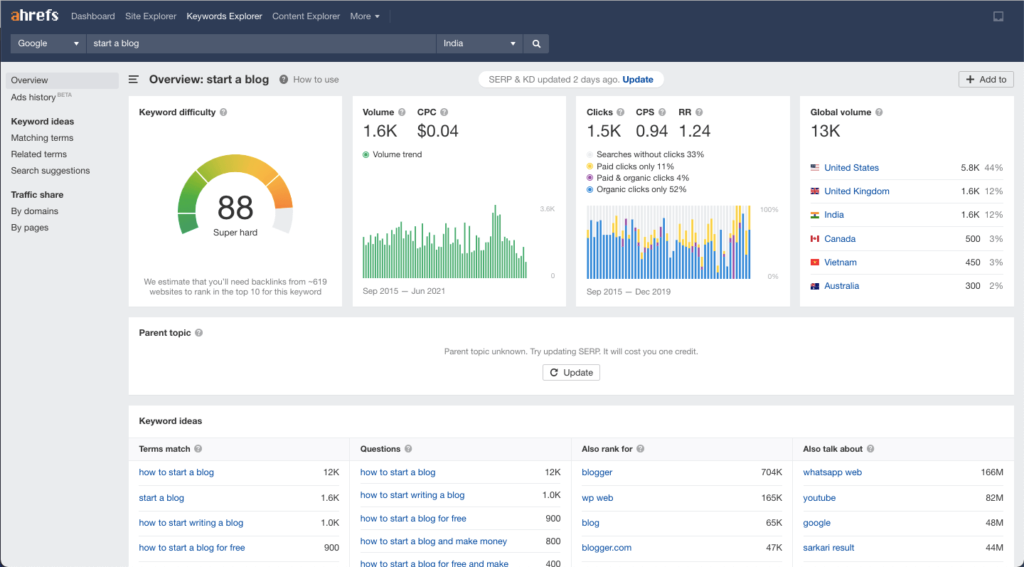
In the meantime, what about the actual posts that you'll be writing? Fortunately, you can write anything you want! Remember, this is your blog, and one of the major benefits is that you have a platform to express yourself and share your thoughts with the world! Ideas, on the other hand, don't always come easily.
The importance of a simple editorial calendar in this regard cannot be overstated. Fill out this simple form, and you'll have a road map always to know what you're going to write next. As a result, you'll have more time to spend on the fun of actually writing blog posts rather than wasting time brainstorming blog post ideas.
5 ways to come up with clever blog post ideas
Here’s a simple process for coming up with the specific blog posts I write for my blog.
5 ways to come up with unique blog post ideas
- Write down all the ideas you come up with: To get started, jot down as many ideas and keywords as you can think of. If you know that your target audience will appreciate it, then go for it! Are they asking any specific questions? What areas of expertise do you have that can help fill in the blanks?
- A keyword research tool can help you come up with more ideas. To develop more keyword ideas, use a keyword research tool such as Ahrefs pictured above, UberSuggest (free), Twinword Ideas (free), or Moz. If you've already come up with a list of keywords, these tools will show you what terms and topics are related to them, as well as how much traffic they get (to show that your audience cares about them).
- Similar concepts should be grouped: Begin by taking all of your terms and refining them. Do you have any duplicates that you can group?
- Assign a priority to each of your ideas in a spreadsheet: Now, go back to your editorial calendar spreadsheet and add your keyword, estimated search volume, difficulty, and opportunity to the list of information. Assign a priority to each of these topics on a scale of 1 to 5. (or a basic High-Medium-Low).
- Outline content that addresses all 3 key needs: Set a deadline for your top priorities and stick to it. It would be best if you looked for topics that address all three of these needs at once: They are relevant to your niche, meet your readers' needs, and have a high potential for search engine traffic. To get started, create an outline for your blog post to help you focus on your key points.
A few more creative ideas may be used if I'm still in need of more ideas.
- Reviewing the content of other bloggers in my niche (and what did well).
- My most popular posts to see what my readers enjoy the most.
- Incorporating more quote roundup posts (such as those on business advice and online business tools) that don't require a lot of original thought and effort on my part.
- It was fun chatting with other bloggers in my area and generating new ideas.
- Lessons I've recently learned (and my advice).
- Taking stock of the blogging mistakes I've made, as well as the strategies that work today,
Now you’re ready to write your first blog post
Once you’ve decided on the first blog post you want to write, you will navigate to the “+ New Post” button on your Blogger Dashboard.
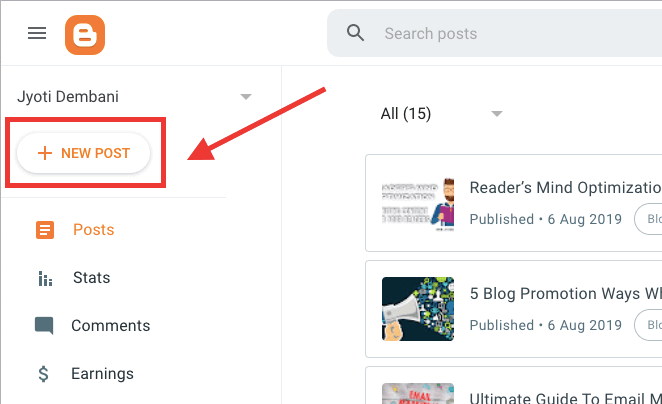
Next, you’ll be taken to a new article page that’ll look like this (a totally blank canvas)
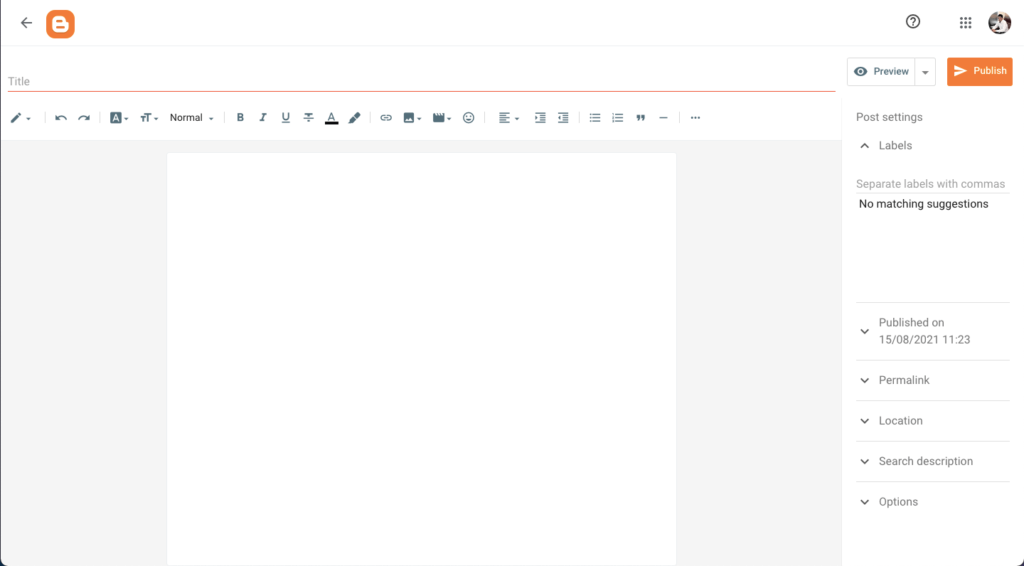
Writing a blog post title that encourages readers to click.
Isn't it true that one of the reasons you blog is to attract new readers? Learning how to write a headline that will entice readers and, most importantly, deliver on the promise of what your article is helping readers accomplish—pays off in the long run.
You decide to write about some of the lesser-known hikes in Northern California in your hiking blog. On your new post page, click the “Add title” button and type in a title like…
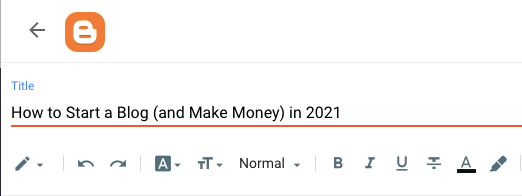
- Do they tend to lead with numbers all of the time?
- Approximately how many of their article titles contain parentheses
- Does capitalizing the first letter of every word seem like a good idea?
I was hoping you could view some of my most recent headlines for ideas on how to structure your own headlines in the future (and read my ultimate guide to writing blog headlines).
Search Google for the keyword phrase you're aiming for, and take notes on how other bloggers have written their titles. Be careful not to copy other bloggers, but it'll give you a good starting point.
Choosing an SEO-friendly blog post URL
Since I want to rank the article “How to Start a Blog (and Make Money) in 2021” for keyword phrases like “Start a blog and make money,” I've chosen the same URL for my post: /start-a-blog-make-money.
The following are a few more pointers for writing URLs:
- If you are creating a new post URL, remember to separate the words with a dash (for easier readability)
- Avoid using more than 3 to 5 words (less is better)
- Numbers should be avoided unless there is a compelling reason to do so
- Be sure to include your target keyword phrase.
Create a compelling introduction for your new blog post
To convince readers that your new post is worth their time, you only have one or two sentences. The following are a few do's and don'ts for writing a strong introduction to a blog post that keeps readers interested.
When it comes to writing a blog post introduction, there are some things you should and shouldn't do.
Do:
- Use a variety of words.
- Start with an eye-opening fact.
- Begin with a quotation
- Use dramatic or humorous language.
- Benefit from the use of eye-catching formatting (like bold and italics)
Don't:
- Utilize a tired cliche that will make your readers snort.
- Get rid of the leade (failing to tease the most interesting point in your article)
- In other words, state the obvious.
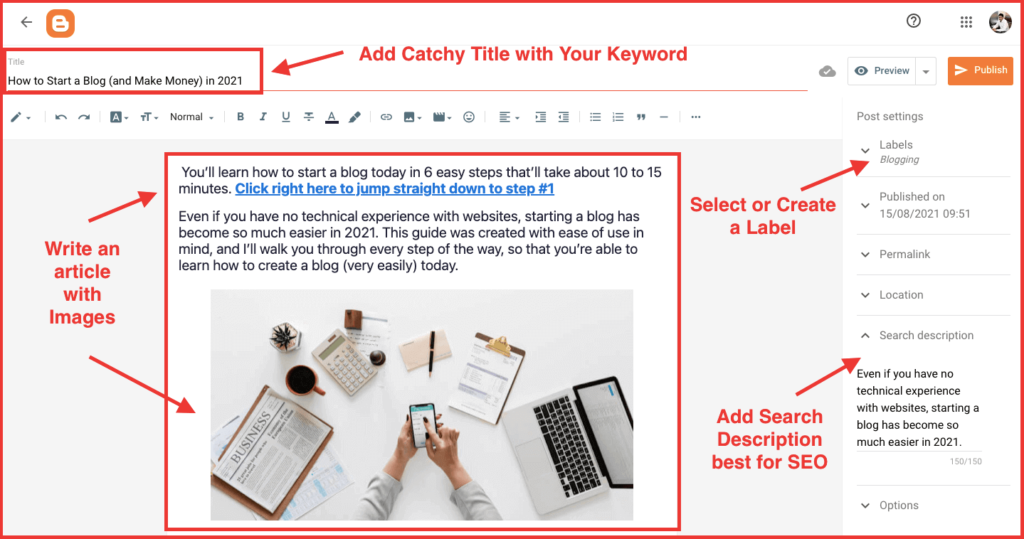
Optimize your blog post —
Before hitting the publish button, you need to optimize your blog post; here are some checkpoints:
- Added a catchy and Keyword Optimized Title
- Added a detailed article with images and videos. First image is your featured image.
- Selected Label (Category) from right side post setting section.
- Edited permalink (or URL of your blog).
- Added a Search Description (Its will show in Google Search Engine)
- Enable Comments (As per your need)
If you already completed the above checklist, then you can publish your first blog post.
Free blog photo resources
If you are looking for free images for your blog post, You can create your own images or use Free Stock Images. Here are some Free blog photo resources:
- Unsplash
- Pexels
- Canva (Create your own custom images)
- Wikimedia Commons
- Life of Pix
Use social media to promote your blog
- Facebook: Videos and curated content
- Instagram: High-res photos, quotes, and Stories
- Twitter: News, blog posts, and GIFs
- YouTube: Create viral video content (2nd largest search engine in the world)
- LinkedIn: Professional content and career news
- Pinterest: Infographics, step-by-step photo guides, visual content
- Reddit: Comments about topics in your niche
Few Other Fantastic Ways to Promote Your Blog
Social media is obviously an ulmite way to promote your blog, but there is lots of other resources you can gain targeted traffic for your blog. Even I am also using same resources and You are on my Blog and reading this, this is success of my blog.
Few more fantastic ways to promote blog posts:
- Guest Blogging — Guest blogging on same niche websites is also a best way to reach targeted audience and increase your web traffic.
- Q&A Sites — Question answer type websites like Quora, Google questionhub, and looking like same websites. Answer questions with your blog link, this technique will obviously increase bulk traffic.
- Forum & Message Boards — Online niche forums will increase your web traffic drastically, Even I have also enrolled few top forum and message board and I got around 50,000+ visits from forums.
- Email Marketing — Email marketing is one of the best and cheapest way to generate a targeted traffic. You need to create a email list from your blogs post and you can reuse it for all future blogs.
4 more creative ways to promote your blog
-
Interview niche toppers: The best way to learn is to talk to famous people in your field. As a bonus, other readers of your blog will be interested in hearing from them as well. You can use these interviews to write blog posts or even start a podcast based on the information provided.
-
Networking with other bloggers: In the early stages of your blogging career, you should network with other bloggers in your niche and mention their blogs. You can do this by mentioning their content on your own. Often, this involves linking to relevant blog posts and then emailing the blogger to say, “Hey! “. In my most recent article, I mentioned you. Would appreciate it if you could share it. Otherwise, I'm happy to continue to share mine.” This has the potential to produce real results, and it can do so quickly.
-
Discuss your plans with others: As simple as it may seem, telling your friends and family about what you're doing can have a significant impact. The first few months of blogging may only have a few close friends reading, but you must reply to every comment and comment on other blogs as well.
-
Observe and learn from other successful bloggers: Consider learning from other bloggers in your niche if you aren't quite ready to connect with them. Find out what works for people who excel at what you're doing. See how you can apply it in your own way.
Only you can prevent your blog from growing. Inventiveness and willingness to experiment are required, but the effort is well worth it.
Before this point, almost every guide to starting a blog gives up. Let me share the tools (and strategies) I've learned from starting a blog to turning it into a real business, based on my experience growing this blog into one with more than 500k monthly readers and $50,000/mo monthly revenue.
You must understand the process of generating income through a personal blog in the long run.
My blog generated a total of $19,107 in revenue last year from a variety of sources.
As a result of my experience in starting a blog and generating income from it, it's important that you understand that I know what I'm doing. This kind of income is rare in blogging, and it's taken me six years to get to this point.
Why does this guide to starting a blog include a section on making money from your blog? If you don't already have a large audience, don't expect to make money right away.
As you embark on this new journey, it's helpful to have a rough idea of how you'd like to make money blogging. It will be easier to implement some of these monetization strategies while your readership is still growing.
1. Selling Your Services (Freelancing)
- Blog writing
- Designing
- Marketing
- Photography
- Web Developer
- Social Media Manager
- Virtual assistant
- Campaign Creator
- Lead generation
- The list is endless… the ability to monetize any skill
2. Affiliate Programs
The affiliate programmes that I'm a member of generating a substantial amount of passive income every month (sometimes above $4,000+). Take an example, a screenshot of my blog's revenue for the last 4 months of last year from just from one affiliate program.
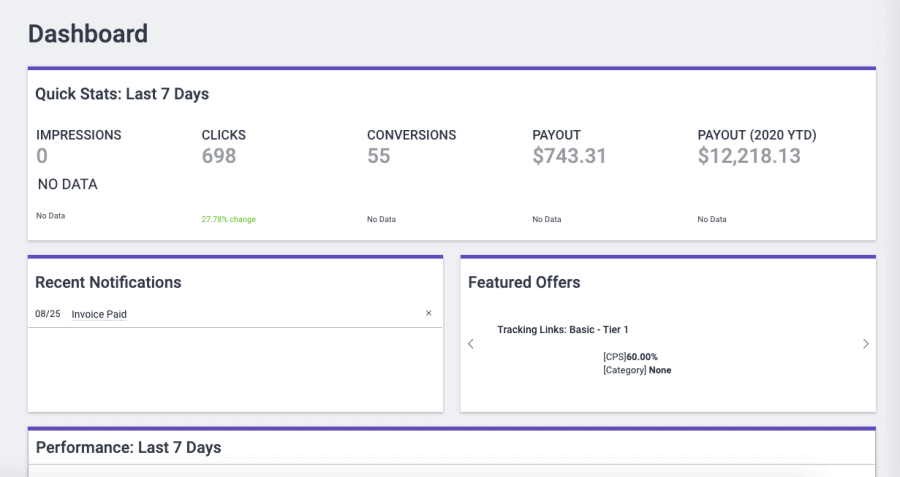
3. Sponsored Blog Content
Your blog (or social accounts) will need some time to grow to a point where the sponsored content is a viable monetization option if you don't already have one.
For blog sponsorships, sponsored content is when a company or individual pays you money for the privilege of promoting their content (or offer).
There are only 9,000 readers in my first year of blogging, but in my second year, traffic increases dramatically. I begin to figure out who my audience is and which traffic strategies work best for me. I began doing sponsored content when my readership grew to around 10,000 monthly readers (on average).
4. Online Courses
There are many ways to package your best advice, strategies, tactics, and tutorials into an online course that people can pay for access to so they can learn much faster than they would by learning through trial and error. My blogging tips are a good example of packaging your best advice, strategies, tactics, and tutorials.
As a result of the launch of my premium blogging course, Built to Blog, last year, I generated over $4,000 in revenue.
You don't have to have a vast audience to make money from online courses. This is the same as you publish an ebook and sell it to their audience.
5. Blog Advertisements (Adsense or Ad Networks)
Blog ads are a traditional way to monetize your blog. Even, I am also using Google Adsense to monetize my blog. On average, I earn $400-$500 per month because my targeted audience is India. This cost will vary on location. Sometimes I got $25 for a single ad click.
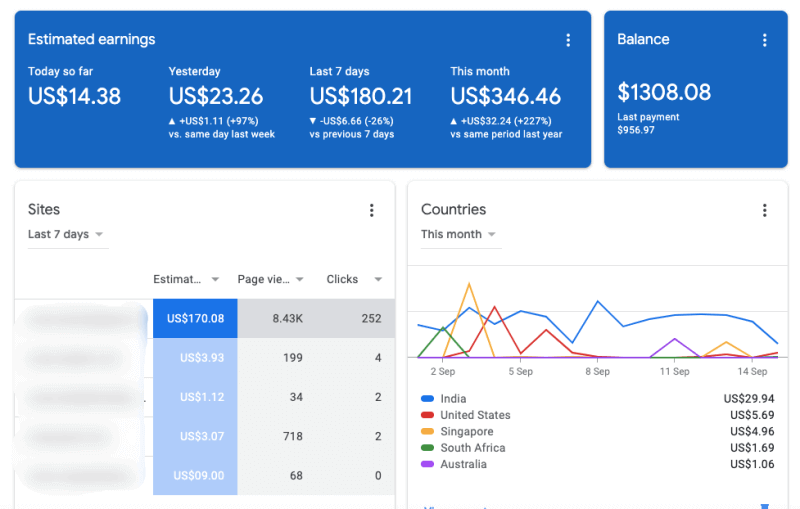
Blog ads are a traditional way to monetize your blog. Even, I am also using Google Adsense to monetize my blog. On average, I earn $400-$500 per month because my targeted audience is India. This cost will vary on location. Sometimes I got $25 for a single ad click.
6. Physical and Virtual Products
If you're starting an eCommerce store (with the right eCommerce website builders) to sell products that your readers need, selling a physical product or software tool is another great way to monetize your blog audience.
All of this boils down to solving the problems that your blog's readers may have. Even more, motivation is provided because 75% of online shoppers use social media as part of their buying process.
With dropshipping and order fulfilment services on the rise, eCommerce is now a great way to monetize your blog's readership.
Additionally, you can use customer loyalty programmes that encourage existing customers to refer their friends to your business by offering discounts for first-time customers, free one-month trials, gifting programmes and other incentives. As a result of these channels, you can use word-of-mouth marketing to spread your message and products at a fraction of the cost of traditional advertisement.
How to Start a Blog in 2023: Final Thought for New Bloggers
Being excited and engaged with your new blog is the key to growing a successful one in the long run! Give them a good reason to read your work.
Connect with people in your niche, and share what you're working on with enthusiasm.
The traffic, monetization and everything else will follow.
Starting a blog has been one of the most liberating and life-changing decisions I've ever made.
And I hope you've gained enough confidence to start your own blog.
To learn more about this guide, I invite you to enrol in my blogging courses. Further topics covered include driving traffic, my own writing process and monetizing your blog.
That’s all for today! Now, if you’re looking for some extra reading to help along on your blogging journey, then here are my greatest hits to read (and bookmark it) today:
- The Ultimate Guide Start A WordPress Blog – Everything You Need to Know
- How To Improve Your Writing Skills
- 6 Stunning Social Media Strategies that Extends Your Global Marketing Efforts
- Do You Blog About The Topic Which You Love?
- 10 Awesome Ways For Finding Blog Post Ideas
- 5 Powerful Methods of Being More Productive Blogger
- How to Increase Blog Traffic: Top 10 Ways That Works
- Top 10 SEO Optimization Tips: Getting 1st Rank on Google!
- How To Encourage First Time Visitors To Stay On Your Blog
- How to Actually Convert First Time Visitors into Returning Readers
- 5 Ways To Gain The Trust of Your Readers
- Begin Your Blogging Career With 5 Important Mistakes
- How to Increase Your Blogging Productivity by 500%
- 3 Simple Blogging Lessons We Can Learn From “The Writer”
- 11 Killer Tips and Tricks for Successful Blogging – Be A Successful Blogger
- Top 10 Link Building Strategies for 2021 That Work
- Digital Literacy: Essential Skills to Boost Your Earning Potential
- Secret Trick Exposed: Earn $250 Daily with CPA Marketing for Free! (Beginner-Friendly Guide)
- How to Create a Wix Dropshipping Store/Website?
- 10+ CPA Marketing Free Traffic Methods: Expert Strategies
- How could I make money if I own a website (not from selling products)?
- Earn ₹2.50 Per Click with IndiaMART Affiliate Program – A Simple Guide for Beginners






